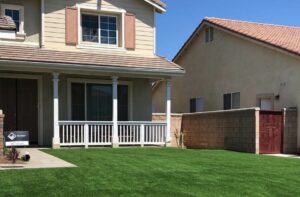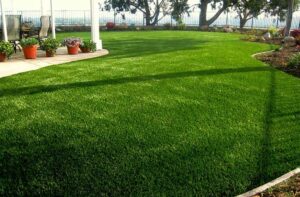The choice between artificial grass vs. real grass has become a significant consideration for homeowners, property managers, and landscape designers alike. With many advancements in synthetic turf technology, artificial grass is a popular option and compelling alternative to traditional natural lawns.
Whether for residential landscapes, grass fields, or public spaces, the choice between artificial turf vs. grass comes down to what a property owner prefers and needs. Knowing the pros and cons of each can help you decide the best artificial grass option for your space.
The Appeal of Natural Grass

Nothing quite matches the feel and smell of natural grass. From the soft, cool touch underfoot on a warm day to the fresh, earthy scent following a summer rain, real grass is simply unique on its own. Visually, a lush green lawn enhances the beauty of a home, giving an otherwise blank and boring space a look that is both welcoming and relaxing.
However, the benefits of natural grass go beyond its beauty. Ecologically, a well-maintained lawn contributes positively to the environment by:
- Producing oxygen
- Capturing dust and debris
- Supporting natural ecosystems
Natural grass areas can also help reduce carbon footprints by absorbing carbon dioxide, making them an essential component of urban green spaces. The ecological impact of growing and maintaining a natural lawn also includes its ability to cool the air around homes, which can reduce the need for air conditioning during hot months.
Maintenance and Cost Implications
Maintaining a natural grass lawn can be costly and time-consuming due to the need for regular maintenance1:
- $3,000 to $150,000 per project: The average cost to seed a lawn.
- $180 to $225 per month: The average monthly cost of watering a lawn, which uses 12,000 and 15,000 gallons of water per month and will really up your water bill.
- $75 to $200 per day: The average total cost of renting equipment, such as power seeders, lawnmowers, leaf blowers, and edgers.
In addition to these expenses, natural grass may also need:
- Seasonal treatments
- Pest control
- Possible re-seeding or sodding to repair damaged areas
These are major contributors to the ongoing cost of natural lawns. In comparison, artificial grass costs much less because it does not need any watering, fertilizer, or monthly maintenance.
The Increasing Popularity of Artificial Turf

Artificial turf is quickly becoming the go-to choice for homeowners and property managers seeking a beautiful, low-maintenance lawn. Unlike natural grass, synthetic turf requires minimal upkeep – no mowing, watering, or battling weeds and pests. Plus, with water conservation being a top priority, artificial grass offers a sustainable solution by eliminating the need for water-intensive lawn care.
Beyond its practical benefits, an artificial lawn is also durable and versatile. High-quality synthetic turf is designed to withstand:
- Heavy foot traffic
- Harsh weather
- UV exposure, ensuring a beautiful lawn for years to come.
From residential yards to commercial landscapes, sports fields, and pet areas, artificial turf adapts seamlessly.
Environmental Impact and Health Considerations
When deciding between natural grass and artificial turf, here are some considerations:
Natural Grass:
- It provides a cooling effect through transpiration, which releases moisture into the air and creates cooler surroundings.
- It also produces oxygen through photosynthesis, absorbs carbon dioxide, and helps in minimizing air pollution.
- Prevents soil erosion and contributes to the overall stability of the ecosystem.
Artificial Turf:
- Requires little upkeep, saving time and effort on tasks like mowing, watering, and fertilizing.
- Its appearance looks more or less the same, year-round, making its appearance one less thing to worry about.
- Fake grass is a lower-maintenance alternative to traditional lawns.
Natural Grass vs. Artificial Turf: Installation and Longevity

When launching a new lawn project, how it’s installed and how long it lasts are the top two questions. This is because the initial installation cost of natural grass is often less than artificial turf; however, maintaining the latter is easily more affordable than the former.
Requirements of real grass installation:
- Soil preparation
- Seeding or laying sod
- An extended period of intensive water and care to establish the lawn
Requirements of artificial turf installation:
- Preparing the base
- Ensuring there is proper drainage
- Laying down a weed barrier
Installing natural grass is often labor-intensive and requires ongoing maintenance to ensure the grass takes root and thrives. On the other hand, while rolling out and securing artificial turf is a process that is initially costly and labor-intensive, there is little follow-up maintenance required.
So, how long does artificial grass last? With proper care, it can last at least 15 to 25 years. This durability makes it particularly appealing for high-traffic areas or in climates where natural grass struggles to survive.
Future-Proofing Your Lawn With Artificial Grass
Choosing between artificial turf and natural grass significantly impacts the long-term usability and aesthetic of outdoor spaces. If you live in an area prone to droughts or dry seasons and/or have water usage restrictions or high water costs, artificial grass is your solution.
Artificial turf is also beneficial in settings where it will see a lot of action. For families wondering if artificial grass is good for dogs and cats, we offer pet-friendly synthetic grass that’s easy to clean up and offers resistance to wear from pet activity. We also have options to keep your turf cool for your pet’s paws like Hydrochill, as well as Durafill to prevent bacterial growth and moisture buildup.
For its part, natural grass has the advantage of being completely real. It provides a natural habitat for wildlife, supports local ecosystems, and biodegrades naturally – with a higher cost.
Consider What You Want From Your Turf

Choosing between artificial turf and natural grass involves many factors, each with its pros and cons. Artificial grass offers an excellent choice for those who prefer a low-maintenance solution that stays green all year round. Natural grass, while requiring more maintenance, supports biodiversity, helps with cooling local climates, and integrates naturally into the landscape.
As you decide which option is best for you, consider your specific needs and outdoor living preferences. You’ll find the best deals on artificial grass rolls at Flooring Inc. to transform your living space into a magical place.
The post Artificial Turf vs. Natural Grass: Which Should You Choose? appeared first on Flooring Inc..
www.flooringinc.com










